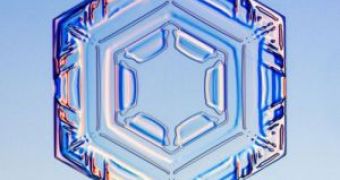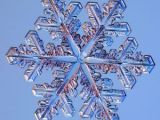Snowflakes are nothing more than ice, but the forms a single flake can take are dizzyingly complex. A single crystal of ice is known as a snow crystal. And one or more snow crystals stuck together make a snowflake. There is, as you've heard, endless possibilities for how they stick together.
For years, Kenneth Libbrecht, a professor of physics at the California Institute of Technology, has been studying the physics of snowflakes, looking at the different patterns of crystal growth and snowflake formation. "I'm trying to understand the dynamics of how crystals grow, all the way down to the molecular level," Libbrecht said. "This is a very complicated problem, and I've been looking at ice as a particularly interesting case study."
At first Libbrecht began by producing snowflakes in the laboratory, and he took microscopic photographs in order to be able to study the basic physics of each flake. "By growing snow crystals in the laboratory under controlled conditions, one finds that snow crystals grow in different forms depending on the temperature and humidity in which the crystal grows. This behavior is summarized in a "morphology diagram," which gives the crystal shape under different conditions." (See diagram for understanding the connection between temperature and humidity on one hand and the shape of the snowflake on the other.)
However, in 2001, he started capturing images of natural snowflakes. As he expected, he found that location is important. "Fairbanks sometimes offers some unusual crystal types, because it's so cold," Libbrecht said. "Warmer climates, for example, in New York State and the vicinity, tend to produce less spectacular crystals.
Since ice is generally transparent, the snowflakes have to be lit properly to reveal their beauty. "I use different types of colored lights shining through the crystals, so the ice structures act like complex lenses to refract the light in different ways. The better the lighting, the more interesting is the final photograph." He has to work quickly, using a paintbrush to place a flake into his portable studio for the shoot. When flakes have fallen, they stop growing - and within minutes they typically lose their sharp edges and become less interesting.
Libbrecht's collection of snowflake pictures can be found here.
The pictures have helped Libbrecht describe growth instability in snowflakes that other researchers had missed. By applying high voltage to a growing snow crystal in the lab, Libbrecht is able to analyze unique growth mechanisms, especially on very small scales. "These instabilities are new and important for understanding how crystals grow, but they're hard to explain," said Libbrecht.
The knowledge acquired by studying snowflakes can be applied in other domains that involve condensing certain substances into solid forms. Such domains include semiconductor manufacturing and nano-technology. In these fields researchers want to obtain certain small predetermined structures via the self-assembly of their components. The growth of snowflakes is one example of such self-assembly occurring in nature.

 14 DAY TRIAL //
14 DAY TRIAL // 
